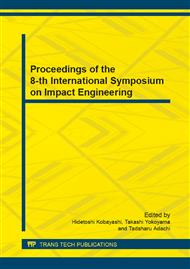p.225
p.232
p.238
p.244
p.250
p.256
p.262
p.268
p.274
Experimental and Numerical Analysis of Repeated Impacts between Two Spheres
Abstract:
The impact of spheres and bodies with spherical surfaces is frequently occurring in engineering applications. Only little research on repeated impacts of spheres is available and the variation of the COR (Coefficient of Restitution) due to repeated impacts is not fully understood yet. Further, the variation of the COR for impact repetition of visco-plastic materials, such as steel, has not been investigated in full detail yet. Therefore, the aim of this study is to investigate the behavior of steel spheres during repeated impact in detail in both, experiments and numerical simulations. In the experiments, two steel spheres are suspended like pendula, and the two spheres collide at the same position with the same initial velocity for every repeated impact. The COR is obtained from the velocity change of the spheres which is measured by LDVs (Laser Doppler Vibrometers) set at both sides of the spheres. The static and dynamic material properties are obtained from material tests and are incorporated into an FEM (Finite Element Method) analysis. The experimental results and the FEM results agree fairly well. It is observed that the COR increases toward to 1 by the repetition of impacts, indicating decreasing amount of plastic deformation in the successive impacts.
Info:
Periodical:
Pages:
250-255
Citation:
Online since:
June 2014
Authors:
Price:
Сopyright:
© 2014 Trans Tech Publications Ltd. All Rights Reserved
Share:
Citation:


